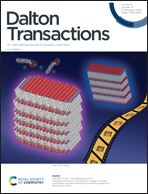Photocatalytic degradation of methylene blue and dye mixture using indium-doped CaWO4 synthesized by sonochemical and microwave-assisted hydrothermal methods†
Abstract
This study presents indium-doped calcium tungstate for the first time. The photocatalytic and photoluminescent properties of pure and In3+ doped samples were investigated. All pure and indium-doped calcium tungstate particles were synthesized for 30 minutes by two different methods: the sonochemical method (SM) and the microwave-assisted hydrothermal method. The nanoparticles were characterized by X-ray diffraction (XRD), field emission gun-scanning electron microscopy (SEM-FEG), UV-Visible spectroscopy, Brunauer–Emmett–Teller method, and zeta potential analysis. The diffractogram results confirmed the formation of scheelite crystalline structures without forming deleterious phases. The SEM-FEG images show the powder with irregular morphology and agglomerated as rods and kibes. For both methods, samples with 8% In3+ ions showed lower PL intensities with maximum peaks at 479 and 483 nm, suggesting lower e−/h+ pair recombination, which led these samples to present better photocatalytic performance. The photocatalytic activity was estimated from the degradation of the methylene blue (MB) dye under UV light and the sample stability was tested in 3 reuse cycles. The scavenger methodology indicated that h+ is the most active mechanism in the photocatalysis process. The degradation of the dye mixture (MB, MO, and RhB dyes) was also performed.



 Please wait while we load your content...
Please wait while we load your content...